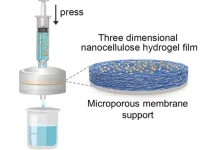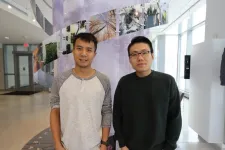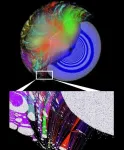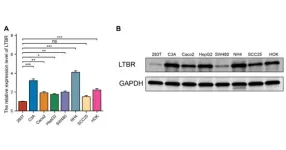(Press-News.org) Color mixing is the process of combining two or more colors: red and green make yellow, blue and red make purple, red and green and blue make white. This process of mixing colors is the basis for the future of solid-state lighting. While currently white light is achieved by phosphor down-conversion, LED color mixing actually has a higher theoretical maximum efficiency, which is needed in order to achieve the 2035 DOE energy efficiency goals. Despite the potential efficiency of color-mixed LED sources, there exists one significant challenge: green. The “green gap” is described as the lack of suitable green LEDs. Current green LEDs are made from state-of-the-art hexagonal III-nitride but only reach one third of the efficiency goals laid out in the 2035 DOE roadmap.
In a new study, researchers at the University of Illinois Urbana-Champaign have found a potential path to fill the green gap and report a green-emitting cubic III-nitride active layer with 32% internal quantum efficiency (IQE), which is more than 6 times higher efficiency than what is reported in the literature for conventional cubic active layers.
“The ultimate goal is to triple the efficiency of today’s white light emitting diodes. And to do that, we need to fill the green gap in the spectrum, which is no easy task. You need innovation. And we show the innovation from the materials side by using cubic nitrides,” says electrical and computer engineering professor Can Bayram, who led this work alongside graduate student Jaekwon Lee.
The results of this research were recently published in Applied Physics Letters as an issue cover article.
Today, the most efficient white LEDs use blue light emitting diodes with a rare-earth phosphor coating that converts the blue light into yellow, green and/or red which enables white lighting. This process is called phosphor down-conversion. The phosphors are luminescent materials that can absorb and convert high energy photons (like blue light) into lower energy/longer wavelength light (such as green, yellow and red, respectively).
This process of phosphor down-conversion, however, has limitations. The down-conversion process is inherently inefficient because the high energy photons must lose energy (in the form of heat) to be converted into photons of other energies. Currently, white LEDs used in SSL generate seven times more heat than light output. Further, phosphors are chemically unstable and add significant raw material and packaging costs (by about 20%) to the LED device. Despite the increase in blue LED efficiency in recent years, SSL using phosphors only has a theoretical maximum luminous efficacy of 255 lumens/watt (lm/W) whereas LED color mixing can achieve a theoretical maximum luminous efficacy of 408 lm/W.
However, many established approaches for green LEDs are plagued with “efficiency droop” at high current densities. Achieving high-efficiency green emission has been difficult with traditional hexagonal III-nitride even with increasing the indium content—a costly element required for green emission—which leads to higher defect densities and efficiency droop. This presents a fundamental challenge for the widespread adoption of SSL.
“We found a way to synthesize low defect density, high quality, single phase cubic gallium nitride by using an aspect ratio phase trapping technique that the Bayram group has invented,” explains Lee. In aspect ratio phase trapping, defects, as well as the undesirable hexagonal phase, are "trapped" inside the grooves so that the surface of the active layer is a perfect cubic-phase material. The cubic and hexagonal phase refers to the way atoms in the materials organize themselves.
Here, the researchers developed a cubic III-nitride system that can enable highly efficient, droop-free green LEDs with a 32% IQE and only 16% indium content. This is the highest reported IQE for cubic wells with ~30% less indium than the amount needed in a traditional hexagonal well.
Bayram says that the green gap can be closed by using cubic III-nitride, as the advantages of these materials for SSL are well documented both theoretically and experimentally. Actual efficiencies of cubic devices have been hampered by the quality and purity of the cubic phase, but the novel aspect ratio phase trapping technique used in this research enables high-quality, pure cubic III-nitride.
Research in the Bayram group builds on Illinois' legacy in LED technologies, which began with longtime Illinois professor Nick Holonyak, Jr., who invented the light-emitting diode (LED) which he demonstrated on October 9, 1962.
*
Can Bayram is also an affiliate of the Holonyak Micro and Nano Technology Laboratory at UIUC.
This research was funded by the Advanced Research Projects Agency-Energy (ARPA-E), the U.S. Department of Energy (under the OPEN Program), and the Office of Naval Research.
END
Mind the (green) gap
2024-01-23
ELSE PRESS RELEASES FROM THIS DATE:
Injectable water filtration system could improve access to clean drinking water around the world
2024-01-23
More than 2 billion people, approximately a quarter of the world’s population, lack access to clean drinking water. A new, portable and affordable water filtration solution created by researchers at The University of Texas at Austin aims to change that.
The new system collects dirty water with a syringe and injects it into a hydrogel filter that weeds out nearly all tiny particles. This device, the researchers say, offers significant advantages in cost, simplicity, effectiveness and sustainability compared existing commercial options, giving users the ability to easily decontaminate water from nearby streams and ...
Gravity helps show strong force strength in the proton
2024-01-23
The power of gravity is writ large across our visible universe. It can be seen in the lock step of moons as they circle planets; in wandering comets pulled off-course by massive stars; and in the swirl of gigantic galaxies. These awesome displays showcase gravity’s influence at the largest scales of matter. Now, nuclear physicists are discovering that gravity also has much to offer at matter’s smallest scales.
New research conducted by nuclear physicists at the U.S. Department of Energy’s Thomas Jefferson National Accelerator Facility is using a method that connects theories of gravitation to interactions among the smallest ...
Cleveland Clinic and IBM Researchers publish findings on artificial intelligence and immunity
2024-01-23
Researchers from Cleveland Clinic and IBM have published a strategy for identifying new targets for immunotherapy through artificial intelligence (AI). This is the first peer-reviewed publication from the two organizations’ Discovery Accelerator partnership, designed to advance research in healthcare and life sciences.
The team worked together to develop supervised and unsupervised AI to reveal the molecular characteristics of peptide antigens, small pieces of protein molecules immune cells use to recognize threats. Project members ...
When some adolescent girls internalize rejection, it really is in their head
2024-01-23
Everyone ruminates about the bad things that happen to them. Whether it’s a nasty breakup, an embarrassing failure or simply when someone is mean, it can be hard to stop thinking about what happened and why. For people who ruminate too much, this negative thought pattern can cause lasting problems with mental health.
A research team led from the University of California, Davis, Center for Mind and Brain found that adolescent girls who have a stronger tendency to ruminate show different patterns of brain activity when faced with social rejection. The study was ...
Researchers design new open-source technology for interfacing with living neurons
2024-01-23
Neurons intricately communicate and respond to stimuli within a vast network, orchestrating essential functions from basic bodily processes to complex thoughts. Traditional neuroscience methods, relying on in vivo electrophysiology (within a living organism), often have difficulty addressing the complexity of the brain as a whole. An alternative approach involves extracting cells from the organism and conducting studies on a culture dish instead (in vitro), providing researchers with enhanced control and precision in measuring neural processes. In a new study featured in Advanced Science, researchers unveil a cost-effective, open-source in vitro system ...
Why do young women with multiple sclerosis face health disparities?
2024-01-23
While recent therapies have the potential to stall or delay the progression of multiple sclerosis, a new study shows that young Black and Hispanic women fare worse than young white women.
Minority women were more likely to have more advanced disease and faced greater challenges in pregnancy, the researchers reported in their study, publishing in the journal Neurology on Jan. 23, 2024.
Researchers tracked medical records at nine MS centers throughout the country for 294 women whose pregnancies resulted in live births. Approximately half of the patients ...
Could two drugs be better than one for treating prostate cancer?
2024-01-23
Combining testosterone-blocking drugs in patients with prostate cancer relapse prevents the spread of cancer better than treatment with a single drug, a multi-institution, Phase 3 clinical trial led by UC San Francisco researchers has found.
The approach can extend the time between debilitating drug treatments without prolonging the time it takes to recover from each treatment.
Prostate cancer affects 1 in 8 men and causes 34,000 deaths each year in the United States. It is usually treated with one of several testosterone-lowering drugs for a set period of ...
Predicting and controlling bad-actor AI activity in a year of global elections
2024-01-23
MEDIA CONTACT:
Cate Douglass; cdouglass@gwu.edu
More than 50 countries are set to hold national elections this year and analysts have long sounded the alarm on the threat of bad actors using artificial intelligence (AI) to disseminate and amplify disinformation during the election season across the globe.
Now, a new study led by researchers at the George Washington University predicts that daily, bad-actor AI activity is going to escalate by mid-2024, increasing the threat that it could affect election results. The research, published today in the journal PNAS Nexus, is the first quantitative scientific ...
When lab-trained AI meets the real world, ‘mistakes can happen’
2024-01-23
First study to examine the impact of tissue contamination on AI models
‘If it’s paying attention to the tissue contaminants, it’s paying less attention to the patient’s tissue that is being examined’
‘Pathologists fear — and AI companies hope — that the computers are coming for our jobs. Not yet.’
Human pathologists are extensively trained to detect when tissue samples from one patient mistakenly end up on another patient’s microscope slides ...
Systematic analysis of the prognostic value and immunological function of LTBR in cancer
2024-01-23
“[...] we identified LTBR as a potential target for cancer immunotherapy and a marker of immune infiltration and poor prognosis.”
A new research paper was published in Aging (listed by MEDLINE/PubMed as "Aging (Albany NY)" and "Aging-US" by Web of Science) Volume 16, Issue 1, entitled, “Systematic analysis of the prognostic value and immunological function of LTBR in human cancer.”
Lymphotoxin beta receptor (LTBR) is a positive T cell proliferation regulator gene. It is closely associated with the tumor immune microenvironment. However, its role in cancer and ...





